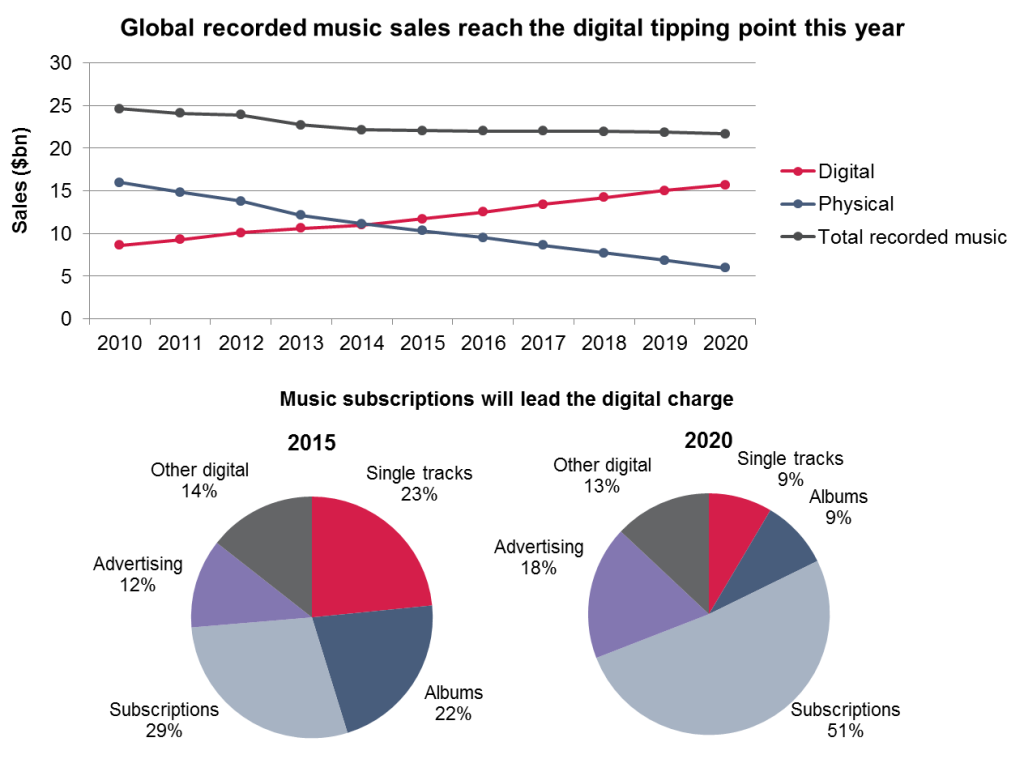Retail sales of recorded music will see little variation in total spending levels in the years to 2020 despite the rising interest in streaming, according to global analyst firm Ovum’s latest forecasts. Spending on digital formats and services will overtake physical formats this year and go on to account for almost three-quarters of all sales in just six years.
According to Ovum’s latest research, the retail value of all recorded music sales is expected to contract this year and next before edging up 0.1% in 2017. However, the slight return to growth is forecast to be short-lived and spending will fall in each of the three years to 2020. Music Practice Leader for Ovum, Simon Dyson and author of the report said “2015 is a big year for the music industry with global retail sales of recorded music crossing the digital tipping point.” Dyson added that “For the first time, digital spending will top physical sales, amounting to US$11.7bn this year (compared with US$10.3bn for physical) and reach US$15.7bn in 2020.” Music subscriptions will lead the digital charge and will dominate retail spending for the foreseeable future.
Global recorded music retail sales, 2010–20

Source: Ovum
For each of the six years forecast, Ovum has estimated that the overall annual difference in the global retail sales figure will not change by more the one percentage point either way. The biggest annual movement is expected in 2020, with a year-on-year dip of 1%.
No anticipated growth in overall consumer spending on recorded music will make difficult reading for the record companies. Moreover, the estimated value of recorded music spending in 2020 is expected to be US$3bn lower than it was in 2010. But there is some comfort in the figures. According to Dyson, “the shift from ownership to access has meant manufacturing and distribution costs have been reduced and, with consumers steadily spending more on access services and less on downloads, costs are going to continue to shrink.”
Dyson says that “the gross income record companies expect to make from physical format sales this year is around US$5.2bn and this will fall to just under US$3bn in 2020. EBITDA is also forecast to decrease, from US$520m to US$300m.”
In contrast, for downloads there are no manufacturing costs and only minimal distribution expenses. The gross record company income from downloads is estimated at US$2.6bn in 2015 and US$1.4bn in 2020, while EBITDA in those years will be US$790m and US$420m, respectively.
The EBITDA share for subscriptions and advertising downloads will be slightly higher than downloads because of lower sales and marketing expenses. Gross record company receipts from subscriptions/streaming are estimated at US$2.4bn in 2015, rising to US$5.4bn in 2020, while EBITDA from subscriptions/streaming is forecast to grow, from US$820m to US$1.9bn.
Taken altogether, gross receipts for record companies from the combined sales of physical formats, downloads, and income from access services are forecast to slip, from US$10.2bn this year, to US$9.8bn in 2020. However, as consumer spending on subscriptions rises, EBITDA will grow, from US$2.1bn to US$2.6bn.
Streaming is riding close to the crest of the recorded music wave at the moment with a good number of trade associations reporting high growth figures and rising subscriber numbers. In some countries, access services are more than offsetting declines in sales of physical formats and music downloads. But, given that physical formats – and to a lesser extent single tracks and digital albums – still account for a sizable share of music retail sales, the streaming sector will be hard pushed to make up for the forecast declines in the buy-to-own formats. “Assuming consumers don’t make a sudden rush to access services, no decline in total sales in the coming years may well be the best result the recorded music industry can hope for,” concluded Dyson.
You must be logged in to post a comment.